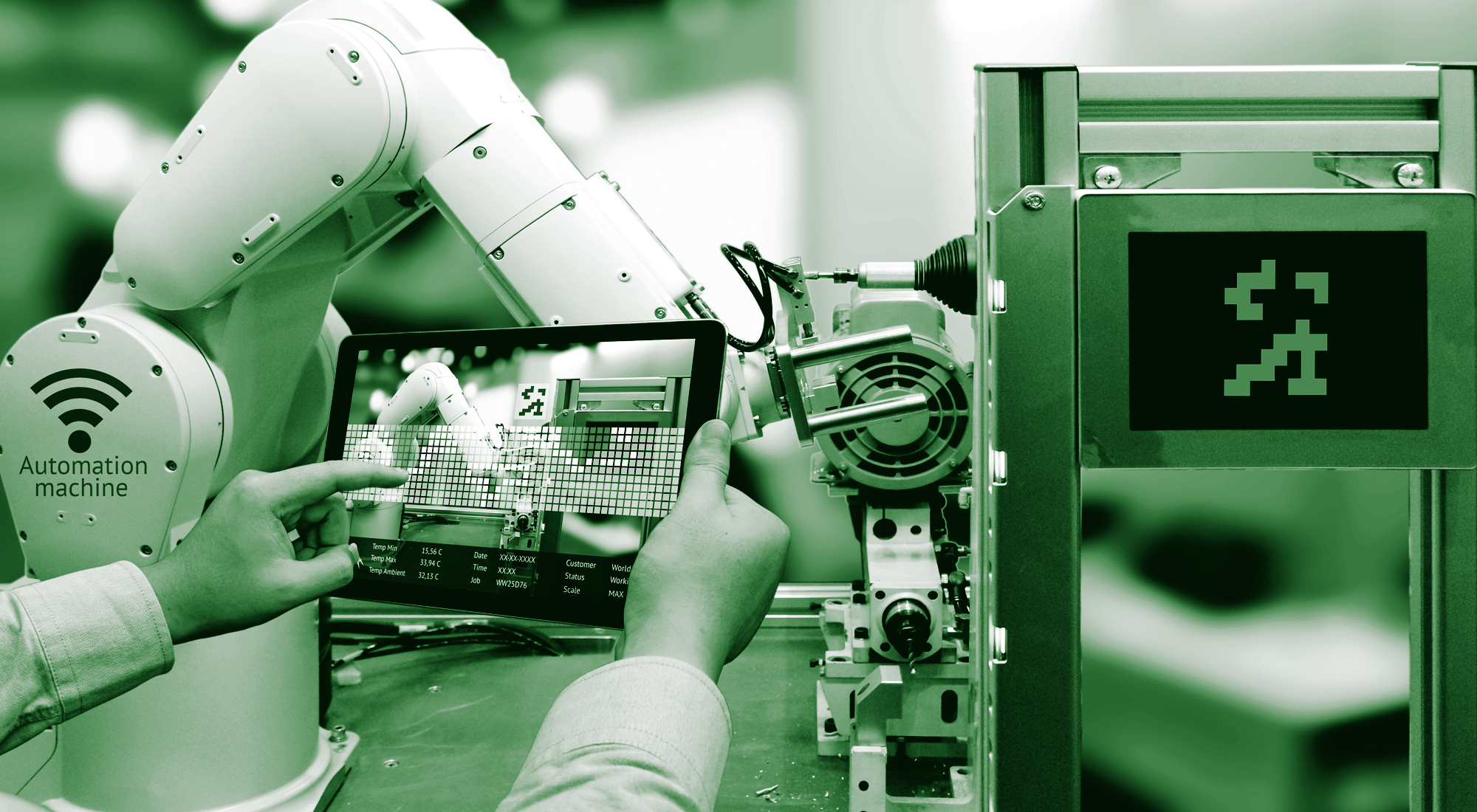Top 5 Technology Trends in Manufacturing for 2017

More than just a fad, these technology trends are here to stay.
According to a new forecast by the MAPI Foundation, the research affiliate of the Manufacturers Alliance for Productivity and Innovation, manufacturing production is expected to increase 3% in 2017 . This acceleration in the market means a great deal of technology will be critical to the advancement of both people and process for your organization. With so many new trends in technology dominating how we do business today, OpenArc thought it best to focus on the emerging solutions for tomorrow. Here are the top 5 technology trends you will see dominating the manufacturing industry in 2017.
-
Artificial Intelligence
Forrester predicts investment in artificial intelligence will grow 300% in 2017 as compared to 2016. That’s an astronomical number, but the returns we’ve experienced already have demonstrated that intelligent insights, when consisting of big data, IoT and AI, create big dividends for not only the companies investing in those technologies, but those investors who are actively investing in those technologies as well. So why is AI ahead of big data and IoT in becoming the most important element in the ‘perfect storm’ of analytics and reporting? The democratization of data is the answer.
The rising trend of adoption of data in numerous forms from numerous sources means that not only will your CIO become your CDO, but so will your CMO. No longer does AI lend itself to one sector of your business. The evolution of responsive robots allows all leaders and all divisions within your company to take ownership of the manufacturing landscape. Translatable and attainable data are the key to making AI possible and relevant to leaders of all disciplines.
So, who is assisting leaders in manufacturing to master the art of Artificial Intelligence? Google of course. Robert Atkinson, president of the Information Technology and Innovation Foundation, announced that “Google is developing an operating system for robots that is just like an Android system, where you can inter-operate platforms across various industries at a lower cost. With this operating system, Google is hoping to dominate the AI application in manufacturing industry.”
-
Digital Twins
We’ve seen the trend of Digital Twins pick up over the last couple of years, and due to the overwhelming savings and response time improvements, we have no doubt this tech trend will shine bright in 2017. The true advantage of the digital twin is to enable predictive failure with real-time data to reduce maintenance costs and downtime. The live transfer of data and reporting allows a manufacturer to cut prototyping and production costs while testing out their wildest projects virtually risk-free.
Reliant on sensor data to understand its state and respond to changes, a digital twin and its physical counterpart can not only improve the build of materials, but the ongoing ROI of your product. Take for example, one of our favorite projects, interACTION. This project’s physical manufactured product ties sensors into app reporting to continually improve the product and ongoing manufacturing improvements for new features. It helps improve the lives of the users in real-time with health care performance reports and it improves itself with the advancement of reporting and collected data. The mutually beneficial cost-saving advancements of physical and digital reporting help improve the product and the user experience quickly and efficiently.
Michael Cooney of Newsweek reports, “Within three to five years, hundreds of millions of things will be represented by digital twins. Organizations will use digital twins to proactively repair and plan for equipment service, plan manufacturing processes, operate factories, predict equipment failure or increase operational efficiency, and perform enhanced product development. As such, digital twins will eventually become proxies for the combination of skilled individuals and traditional monitoring devices and controls (for example, pressure gauges, and pressure valves).”
-
Intelligent Apps & Seamless Field Communications
This is the year we will really see IoT come to life in practical and effective solutions. Apps that create instant solutions, advanced reporting and seamless field communications are important, as well as a necessity for the new frontier of manufacturing. Something that we have specialized in is size, selection and configuration systems. Today this technology is currently proving successful for some of the largest manufacturing agents around the world who are looking to improve the efficiency of delivering large complex manufacturing.
An example of this technology is InSite by Rewyndr. This tool is one of many that are transforming the idea of “intelligent apps” into an “intelligent workflow.” Manufacturers faced with field operations issues such as slow response time, inefficient product development forecasts, and rising transportation logistics overhead costs will benefit most. Empowering your team with the data they need to quickly to respond effectively will not only show financial gain in cutting unnecessary spending, but that you are investing in their ideas and the future of improving processes and products.
-
Disruptive Manufacturing
The face of manufacturing is changing at lightening speed. 3D printing of parts, salvaging waste materials, precision reporting for the elimination of waste and the improved transportation of goods are just a few of the great ways that manufacturers are going to “go green” in 2017 and shake up the traditional manufacturing landscape. We guarantee the wave of disruptive manufacturing is bound to shake up your future for the better.
Intelligent applications and their digital twins give you the knowledge and the ability to improve responsiveness to changing needs in your factory and in the field. Thanks to additive manufacturing those new and improved schematics are tested on the spot and then sent instantly to production facilities with 3D Printing technology to be constructed. Thanks to this style of manufacturing it is possible to solve problems with advanced troubleshooting without going through large scale production runs on an estimated cure to your machine’s problem. Investing in this technology will add rapid prototyping, advance reporting and improved response time to your vocabulary and your service offering. In summary, consider your new idea a reality to be created, tested and virtually shipped in less than half the time and with the benefit to your bottom line.
Aside from investing in new technology, investing in your workforce will pay greatly as well. Investing in the future of efficient green manufacturing specialists is at the top of the list for leading universities across the country who see this trend as a permanent way of life for the manufacturing industry. Programs like Purdue University’s GreenED Technical Assistant Program are standing firmly for improved process and the elimination of waste through focused studies geared at preparing the future workforce to be reactive and proactive to this changing industry.
-
Automation
Well, before we begin to wonder if we’ll be replaced by a robot in 2030, let’s take a moment to talk about the benefits and the areas of growth for our future workforce working hand-in-hand with automation. We’ve seen industries like food service and auto manufacturing already affected by the advances in automation. Repetitive jobs on assembly lines are the most at risk and if you have a large group of individuals working for you in those roles right now you probably have some difficult decisions to make in the years ahead. Yes, you should invest in the tools needed to gain a competitive edge in your industry and that will mean investing in advance automation processes, but if you do not evolve your workforce to compliment those devices and procedures you will surely be set up to fail.
First, we recommend acknowledging and evaluating the irreplaceable qualities your employees provide your company such as adaptability, ingenuity, integrity and most importantly, the ability to interact with other humans. Secondly, evaluate your more “repetitive” or process-oriented roles. Are those roles an evolution to more advanced technical roles within your organization? Investing in their development with critical thinking and reporting skills will be the key to keeping your company afloat during this transitional time. Lastly, remember that both improving your organization’s process and personnel should always be equally important. A bottom line will only continue to survive as long as your reputation. If you are known for valuing your people, your profits will mirror that.
Want to learn more about our technology experts and how we can apply tomorrow’s technology to your company today? OpenArc is here to answer any questions you may have to make 2017 a great year for your organization. Contact us today!
*Resources include:










